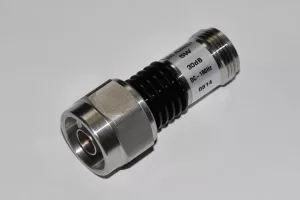
Attenuators: What They Are and How They Work?
October 08 2023 
Inquiry
Global electronic component supplier AMPHEO PTY LTD: Rich inventory for one-stop shopping. Inquire easily, and receive fast, customized solutions and quotes.
QUICK RFQ
ADD TO RFQ LIST
From traffic control to audio engineering, attenuators are essential in many different fields. In order to ensure safety and best performance, these gadgets are made to lessen the strength of signals or impacts. In this blog, we will explore the world of attenuators, including definition of attenuator, their types, applications, and how they work. Whether you're interested in attenuators for traffic control or guitar amplification, this blog will provide you with valuable insights into the functionality and uses of attenuators.
What is an Attenuator?
An attenuator is an electronic device that lowers a signal's strength without significantly altering its waveform.
Types of Attenuators
Fixed Attenuators: Commonly employed in a variety of electronic systems, fixed attenuators offer a defined degree of attenuation. They cannot be modified and have an attenuation value that is predetermined, such as 3 dB, 6 dB, 10 dB, or higher. There are several distinct fixed attenuator arrangements, including inline, pad, and pi attenuators.- Inline Attenuators: These attenuators reduce the signal's amplitude by a predetermined amount and are put directly into a signal route. They are frequently employed in telecommunications, audio, and RF systems.
- Pad Attenuators: Pad attenuators have a set attenuation value and are made up of a string of resistors. They are frequently utilized in audio systems to regulate loudness or match signal levels.
- Pi Attenuators: The Greek letter "π" is represented by three resistors arranged in a triangle-like configuration. They are frequently employed in RF systems to match impedance and regulate signal levels since they offer a set attenuation value.
- Manual Variable Attenuators: These attenuators have a physical control that lets the user change the attenuation level, such as a knob or dial. They are frequently used in RF applications, test and measurement devices, and audio systems.
- Step Attenuators: Using a switch or other control mechanism, step attenuators offer discrete attenuation levels that can be chosen. They are frequently used in RF testing and calibration because they provide fine control over signal levels.
- Voltage-Controlled Attenuators (VCAs): Electronically controlled VCAs are attenuators that enable manual or remote attenuation level modification. They are frequently employed in signal processing, audio mixers, and communication systems.
- Fixed Optical Attenuators: Commonly employed in fiber optic networks, fixed optical attenuators offer a fixed degree of attenuation. They come in a variety of varieties, including plug-style attenuators, bulkhead attenuators, and inline attenuators.
- Variable Optical Attenuators: Attenuation levels in fiber optic systems can be adjusted with the use of variable optical attenuators. They are frequently utilized in applications requiring precise control of optical power or in testing and measurement settings.
Video related to Attenuators
What does an attenuator do?
- Increase or decrease the circuit's signal size.
- standard relative. as a benchmark for comparable comparison of power levels.
- The attenuation value of the tested network can be directly read using the measuring circuit for the comparison method.
- Strengthen impedance matching. In order to mitigate the effect of an impedance change, an attenuator can be placed between a circuit and the real load impedance if some circuits demand a relatively stable load impedance.
- Power level control. The output power of the local oscillator is regulated in the microwave superheterodyne receiver to get the best noise figure and conversion loss of the photosensitive attenuator to get the greatest reception effect. It is possible to use automatic gain control in the microwave receiver to increase dynamic range.
- Used to prevent radar jamming. It is a variable attenuator with the ability to abruptly modify attenuation. In most cases, it does not introduce attenuation; however, when it comes into contact with outside disturbance, attenuation is dramatically increased. The attenuator is a through-type microwave component and a two-port lossy microwave network from the perspective of a microwave network.
How Do Attenuators Work?
Attenuators function by either absorbing or releasing energy. When using an electrical attenuator, the circuit's resistors and capacitors absorb the signal's energy, lowering its amplitude. When it comes to acoustical attenuators, the materials inside the attenuator that absorb sound absorb the sound waves' energy, lowering their amplitude. When it comes to mechanical attenuators, the dampers or springs disperse the vibration's energy, lowering its amplitude. Here is a step-by-step explanation of how a fixed attenuator works:- The signal is applied to the input of the attenuator.
- The attenuator introduces impedance into the circuit.
- Some of the signal is reflected by the impedance.
- The reflected signal is subtracted from the original signal.
- The attenuated signal is transmitted from the output of the attenuator.
Applications of Attenuators
- Attenuators are typically used to attenuate a stronger signal in radio, telephone, and transmission line applications.
- In broadcasting stations, resistive attenuators are employed as volume controllers.
- Circuits with various resistive impedances can be matched using resistive attenuators.
- When it is necessary to get a small value of voltage or current for testing purposes, variable attenuators are employed in laboratories.
- Applications for DC-blocking attenuators include satellite systems, microwave links, test & instrumentation, and telecom infrastructures.
- In optics, attenuators are used to reduce the intensity of a beam of light. This can be done to shield the eyes or to stop the light from harming other optical parts.
- In acoustics, attenuators are used to reduce the sound level of a noise source. This might be done to shield the ears or lessen environmental noise pollution.
Attenuator Truck
An impact attenuator is a piece of equipment that is installed on an attenuator truck. Impact attenuators are devices that lessen the force of collisions between automobiles and roadside obstructions. The energy of a crash is often absorbed by impact attenuators, which are typically comprised of crushable materials. They might be built to steer the car away from the obstacle along the road. Construction zones and other regions with a high crash risk frequently use attenuator trucks. They can also be utilized to safeguard personnel and tools at construction sites beside roadways.Crash Attenuator
A crash attenuator is a tool intended to lessen the severity of collisions involving cars and other roadside objects. Crash attenuators are typically constructed from materials that can be crushed and absorb impact energy. They might be built to steer the car away from the obstacle along the road. In situations where there is a significant danger of crashes, such as construction zones, crash attenuators are frequently employed. They can also be utilized to safeguard personnel and tools at construction sites beside roadways.Attenuators in Traffic Safety
Attenuators are also used in traffic safety to lessen the severity of auto accidents. When there is a chance that a vehicle will collide with a fixed item, attenuators are often positioned at the ends of work zones and other regions. Attenuators are made to absorb the force of a collision and lessen the energy that is passed to the car and its occupants. There are two main types of traffic attenuators:- Truck-mounted attenuators (TMAs): Usually employed to protect employees in construction zones, TMAs are placed on trucks. TMAs are made to withstand the force of a collision and stop a vehicle from striking the workers.
- Trailer-mounted attenuators (TMAs): Attenuators that are attached to trailers are known as trailer-mounted attenuators, or TMAs, and they are frequently employed to safeguard stationary items like overpass abutments and bridge supports. TMAs are made to withstand the force of a collision and shield the stationary object from harm.
Conclusion
You are already familiar with the fact that attenuators are adaptable tools with a wide range of uses thanks to this blog. They operate by decreasing a signal's loudness. Depending on the attenuator type, there are various ways to accomplish this. To lessen the severity of collisions involving automobiles and roadside items, attenuators are utilized, specifically attenuator trucks and crash attenuators.Related Articles
- ·Stratix 10 VS Stratix V: Which FPGA is Right for Your Next Project?
- ·Intel Xeon Platinum 8454H vs AMD EPYC: Which Reigns Supreme?
- ·A Deep Dive into the AMD EPYC 4564P Processor
- ·MSP430F5438A vs MSP430F5529: A Detailed Analysis of Their Capabilities
- ·Comparing MSP430F6659 and MSP430F5419A: Which One is Right for Your Project?
- ·Exploring the Features of MSP430F5529 and MSP430F5638 Microcontrollers
- ·Demystifying 20 Microcontroller Projects for Beginners
- ·Unveiling the Ultimate Guide to Microcontroller Programming
- ·4680 Battery: Unveiling the Power Potential of the Next-Gen Cell
- ·Exploring the Case Studies on Arduino Applications
Populer Posts
